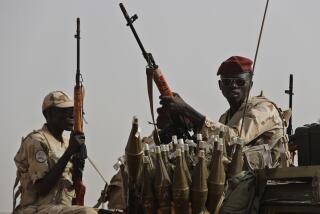Rebels Kill 300 Liberia Refugees, U.N. Aide Says
- Share via
ABIDJAN, Ivory Coast — Liberian rebels Sunday slaughtered 300 refugees--mostly women and children--at an abandoned rubber plantation outside Monrovia in an “orgy of killing and mutilation,” a U.N. official said.
The massacre was the worst in Liberia’s 3 1/2-year-old civil war since government soldiers killed 600 members of rival tribes in Monrovia in 1990.
“They cut throats, they cut heads . . . broke legs and shot, so many bullet wounds that you cannot understand why,” Augustine Mahiga, representative of the Office of the U.N. High Commissioner for Refugees, said in a telephone interview.
He spoke after viewing what he called “scenes more horrible than any movie I’ve ever seen.” He said the killings began just after midnight Saturday and must have lasted for two hours. Most victims were women and children, he said.
Mahiga said witnesses blamed guerrilla leader Charles Taylor’s rebels, who started the war in 1989. Since then, Liberia has collapsed into chaos, and more than half of its 2.3 million people are refugees.
But Taylor denied responsibility for the massacre, telling the British Broadcasting Corp. that it was another attempt to give his army “a bad name.”
He said he believes the killings were carried out, as the pretext for an offensive against him, by Liberian army troops and another rebel faction, with the consent of a West African intervention force sent to end the war.
“It is all a part of this deal where they are planning a massive, a big push (against me) . . . and they are trying to find a pretext for this murder and mayhem they want to carry out,” Taylor said.
The massacre came two weeks after the West African army said it intercepted a radio message from Taylor to one of his commanders in which he allegedly ordered a “reign of terror” against refugees on the front lines of the civil war.
Taylor denied sending the message, but Mahiga and others who have listened to it said they recognized the guerrilla chief’s distinctive baritone.
Mahiga said he and others estimated that about 300 people were killed and 765 were wounded Sunday at Kata, a camp of refugees set up at the workers’ compound of an abandoned Firestone complex that is the world’s biggest rubber plantation. The site is 35 miles northeast of Monrovia, the capital.
He said survivors told him that Taylor’s guerrillas had come looking for food just after midnight Saturday, a day after the United Nations had distributed rice in the area.
“They collected the rice, then went on an orgy of killing of mutilation. . . . They went from house to house killing entire families in the most horrifying manner,” he said.
“I saw (the bodies of) a mother who was trying to protect her son and the same time had a baby on her back, the mother was shot, the baby’s skull had been slashed open. . . ,” Mahiga said.
A second refugee camp was attacked and the death toll may be much higher, he said.
Mahiga said people were speculating that the rebels were using body parts for witchcraft, which is common in West Africa.
Taylor began the fighting with an invasion from the Ivory Coast in December, 1989, sparking a civil war that killed an estimated 60,000 people in 1990.
West African states swamped with refugees sent an intervention force that has grown into a six-nation Nigerian-led army of about 12,000.
The West African troops have gradually pushed Taylor’s forces north, but progress has been slowed by a rebel counteroffensive that began last month.
Mahiga said hundreds of people who had taken refuge at the Firestone plantation, on the front lines of the war, were walking toward Monrovia, which already is overcrowded with displaced people.
“God knows where they will go, and it won’t take more than a day for them to reach Monrovia,” he said.
More to Read
Sign up for Essential California
The most important California stories and recommendations in your inbox every morning.
You may occasionally receive promotional content from the Los Angeles Times.













